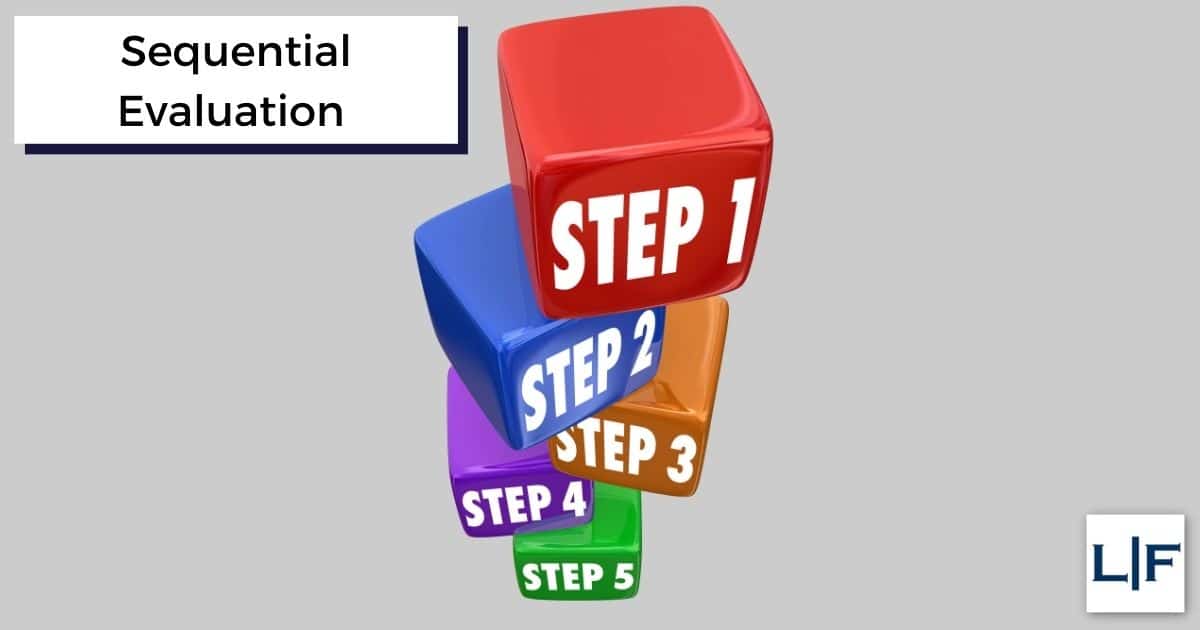Every adult Social Security disability case is evaluated using the same process – the 5 Step Sequential Evaluation as set forth in the Social Security regulations.
Step 1 – Are you working?
Social Security looks to see if you are performing substantial gainful activity (“SGA”). If you are not working at all or if the work you are doing is not considered to be substantial gainful employment then the evaluation moves on to step 2. If you are working and that work meets the definition of substantial gainful activity (even if it is part-time work) you are not eligible for benefits.
SGA has a formal definition but generally, Social Security sets a threshold earning amount. If you are earning over $1090 a month, it is presumed that you are able to work and not eligible for disability. There are certain expenses that can be deducted from this income. If you are working at all and are considering applying for disability, it is a good idea to speak to an attorney about your specific situation.
Step 2 – Do you have a severe medical impairment?
A severe medical impairment is a mental or physical condition that impacts your ability to work in more than a minimal way. Being diagnosed with a medical condition is not enough. The symptoms you experience from that condition must affect work-related tasks. Examples include difficulty walking due to diabetic neuropathy, an inability to concentrate due to depression or trouble lifting things because of a back problem. The medical condition must be diagnosed by a medical doctor, psychiatrist, or Ph.D. level psychologist.
The severe impairment must also meet a durational requirement. It must have lasted for 12 months, be expected to last 12 months or to end in your death.
Step 3 – Does your medical condition meet the criteria in the Listings?
Social Security regulations contain a set of medical impairments with a list of criteria for each condition. If your condition is so severe that it meets all of the criteria, your condition “meets the Listing” and you are considered disabled by Social Security. The criteria are very detailed and it is very hard to meet them. A person who meets the Listing criteria is usually very ill, possibly terminally ill, and there will be a lot of medical documentation to support a determination by Social Security that a person qualifies for disability on this basis.
If your conditions do not meet or equal the severity required for a finding of disability at this step then Social Security will determine your residual functional capacity (“RFC”) for work. Your RFC is a list of things that you can still do, despite your impairments. It includes things like how many hours you can stand and walk in a work day, how much weight you can lift, your ability to perform simple tasks, follow directions, and get along with the public, co-workers, and supervisors.
Step 4 – Can you do your past relevant work?
Social Security will look at the work you have done before to see if you can still perform that work. Not all work is past relevant work (“PRW”). To be PRW it must be work that has been performed in the past 15 years, qualify as SGA and lasted long enough for you to learn how to perform the work. If you can still do work you have done before, you will not qualify for disability benefits. Many part-time or temporary jobs are not considered to be PRW, but there are exceptions to this general rule. If you have questions about your work history and how it might affect your claim for benefits, please contact us.
Step 5 – Can you do other work?
Once the decision has been made that you can no longer do any of your past work, a determination must be made about your ability to perform other work that exists in the national economy. If you can perform other work based on your RFC then you are not disabled under Social Security’s rules. If there is no work in the national economy that you can perform then you will be found disabled by Social Security. As long as the work exists in significant numbers (more than a couple of hundred positions in the country) then it will be considered. Social Security does not care if the job doesn’t exist in your town or that no one is hiring. You can all read about other things Social Security does not consider when looking at your claim.
At this step, Social Security considers your age, education and work experience (skills you may have acquired) when determining if you can perform other work. If you are over 50 years old there are some rules in place that may make it easier for your to qualify for payment.
As you can see, getting approved for disability can be very difficult and requires a lot of medical evidence. At Lunn & Forro we help our clients understand the process and develop the medical evidence needed to support their claim for disability benefits. Please use our contact form or call us at 888-966-6566 if you want to discuss your case.
Related Posts

When am I Considered Disabled by Social Security?
Social Security considers you to be disabled when you have a serious medical condition that prevents you from working. To determine whether a person is

What Is SSI?
Supplemental Security Income (SSI) is a safety net for certain individuals with low income and little assets. SSI provides money so these people can meet

What Is SSDI – Social Security Disability Insurance?
SSDI, which is also called Social Security Disability Insurance, is a government program that gives disabled American workers a monthly income. When you suffer from

Can You Receive Inheritance While on Social Security Disability?
Yes. Inheritance can affect Social Security disability benefits. Much depends on the type of benefit you receive. Below, we discuss the implications of inheritances in
Can I Qualify for Both SSI and SSDI Disability Benefits?
Yes. In some cases, you may be able to qualify for both Supplemental Security Income (SSI) and Social Security Disability Insurance (SSDI) benefits. The Social
What are the Disability Listings for a Social Security Claim?
The disability listings can make it easier for you to qualify for Social Security disability benefits. If you are considering filing an application for Social
How Do I File a Disability Appeal?
You gave Social Security Disability all the information they asked for and agreed to a medical exam, but your disability claim was still denied. It
What If I Miss My Social Security Appeal Deadline?
What is the Social Security Disability Appeal Deadline? The most common Social Security Disability appeal deadline is 60 days. If your initial claim is denied,



